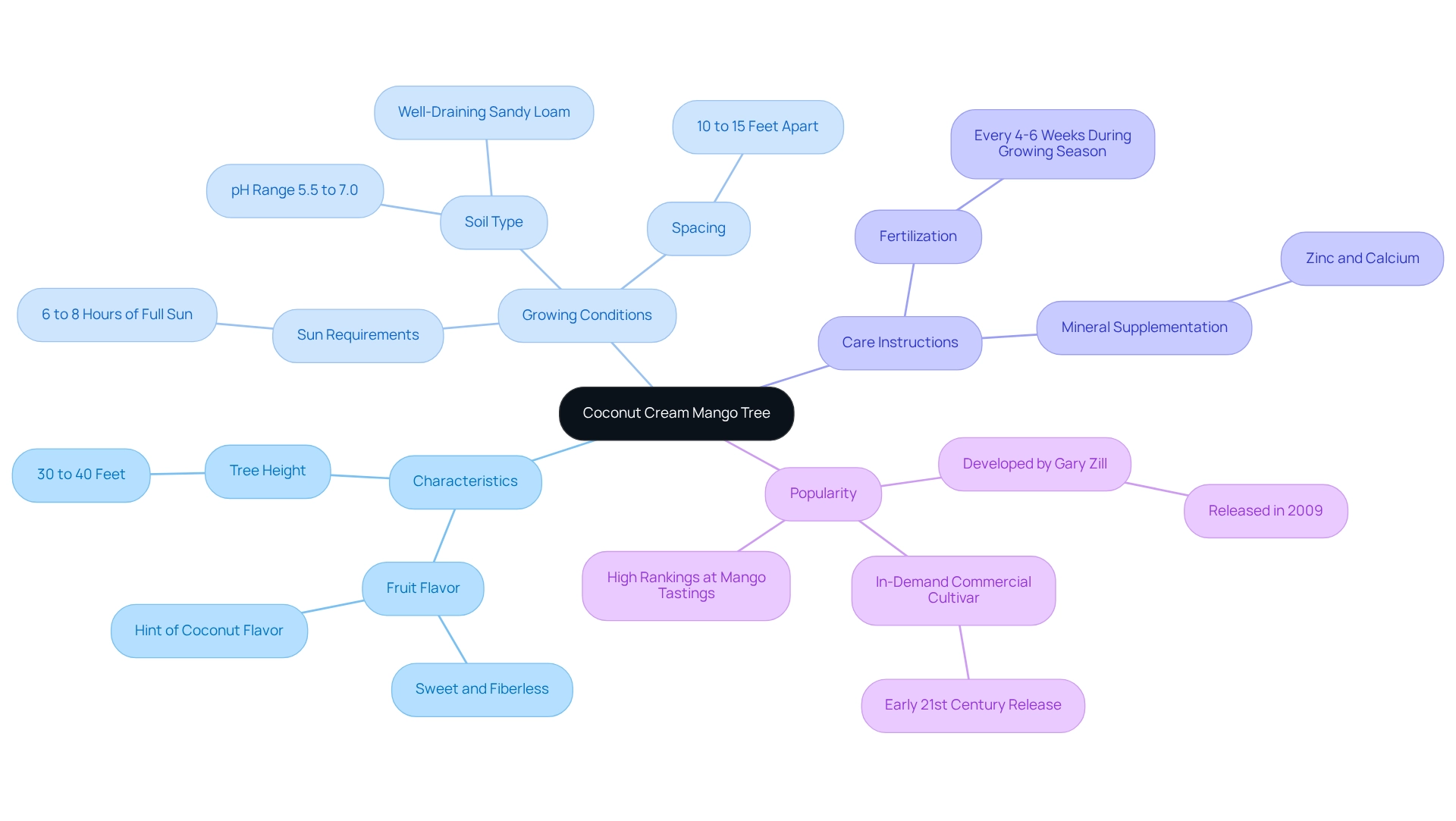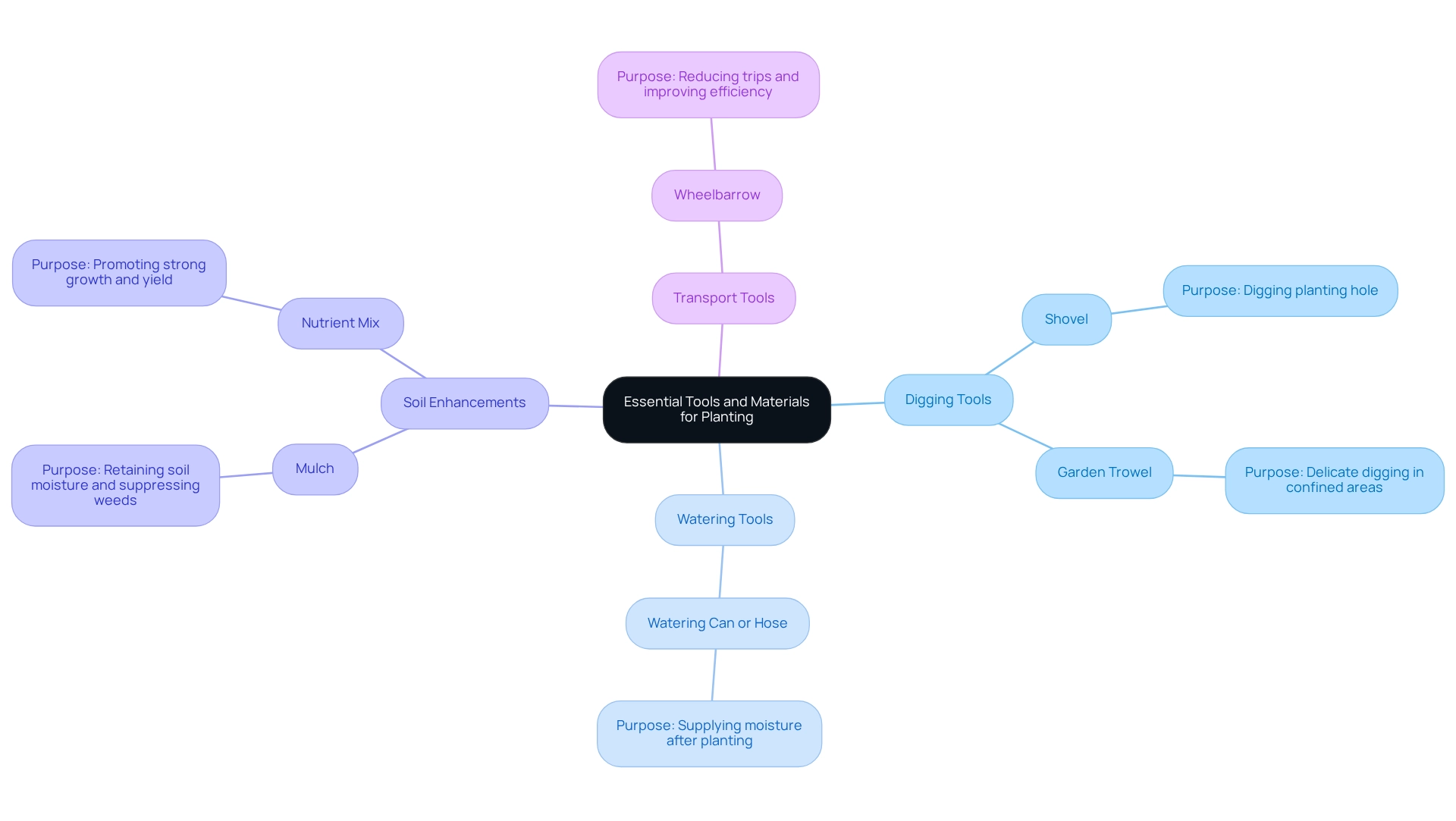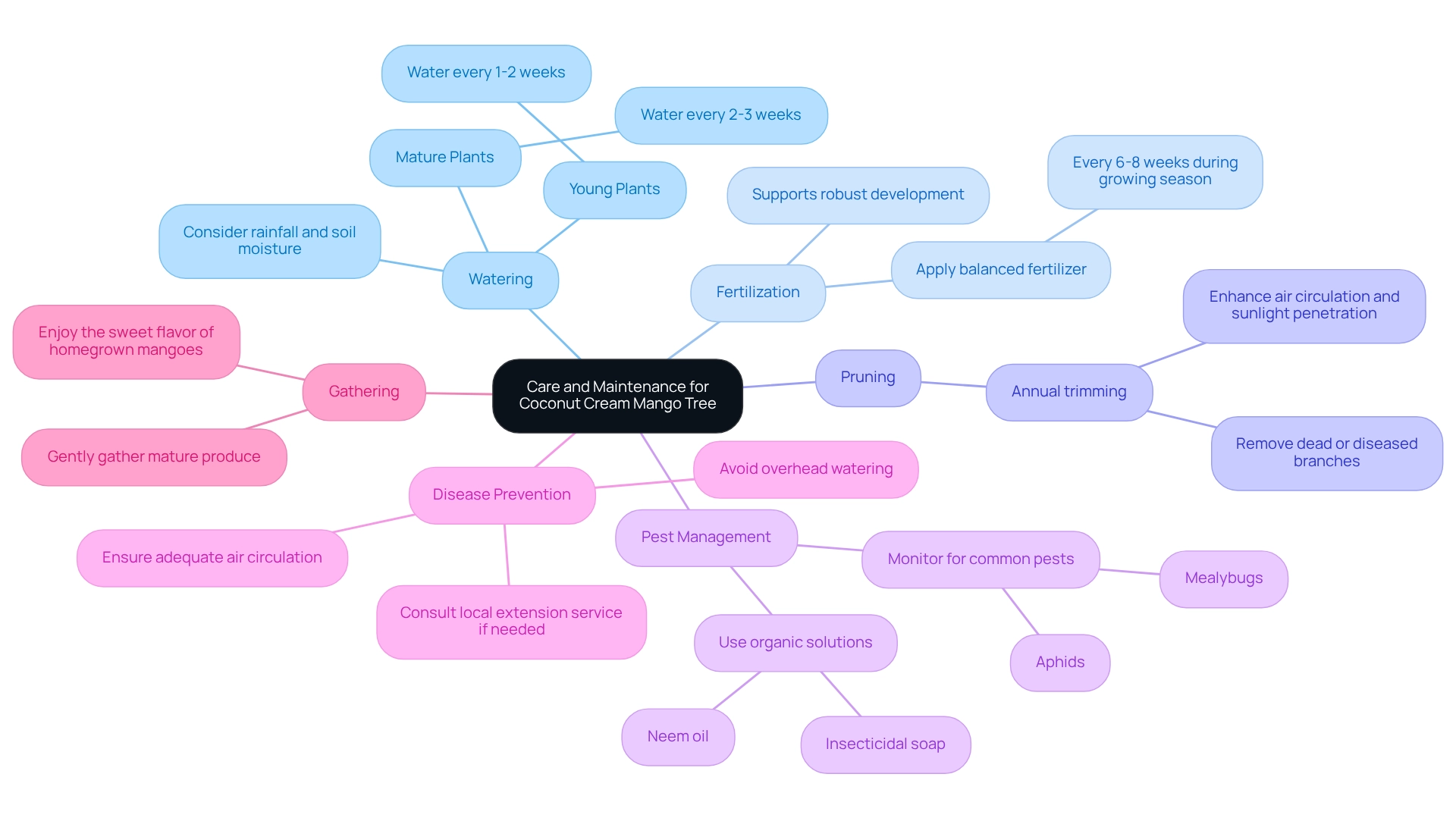Craving tropical mangoes with a creamy coconut twist?
Meet the Coconut Cream Mango Tree—a medium-sized tropical gem that offers sweet, fiberless fruit with a hint of coconut. Whether you’re an experienced gardener or a passionate beginner, this guide walks you through planting and caring for your tree the right way.
📍 Buy Your Coconut Cream Mango Tree from Everglades Farm — shipped healthy and grafted for success.
Also explore:
This article serves as a heartfelt guide for planting and nurturing your Coconut Cream Mango Tree, highlighting the ideal conditions and caring practices essential for abundant fruit production.
Have you ever faced challenges in your gardening journey? Selecting a sunny spot with well-draining soil is crucial, as is establishing a proper watering and fertilization routine.
Regular pruning not only supports growth but also enhances the quality of your mangoes. Remember, with attentive care, you can cultivate a thriving and fruitful mango tree that brings joy to your garden and home.
Let's embark on this nurturing journey together!
Introduction
In the world of tropical gardening, few fruits evoke the same excitement as the Coconut Cream Mango. This delightful fruit is renowned for its sweet, fiberless flesh and a subtle hint of coconut, making it a true treasure for any garden. Imagine adding a medium-sized tree that not only offers a delicious harvest but also brings a touch of exotic beauty to your outdoor space.
Thriving in warm climates, the Coconut Cream Mango Tree requires specific care, yet it presents a wonderful opportunity for gardeners eager to cultivate a unique and rewarding fruiting experience. Have you ever dreamed of nurturing a tree that yields such delightful fruit? From understanding its growth requirements to mastering the planting and maintenance techniques, this guide is here to support you. Together, we will explore the knowledge needed to nurture this exceptional variety and enjoy the fruits of your labor.
As we embark on this journey, remember that every gardener faces challenges. But with patience and care, you can overcome them and create a flourishing garden. Let's dive in and discover how to make your Coconut Cream Mango Tree thrive!
Understand the Coconut Cream Mango Tree: Characteristics and Growing Conditions
The medium-sized Coconut Cream Mango Tree variety brings joy to gardeners with its sweet, fiberless fruit, infused with a delightful hint of coconut flavor. Imagine a tree reaching heights of 30 to 40 feet, yet easily pruned to fit your garden’s unique space. Thriving in USDA hardiness zones 9b to 11—where the minimum average temperature ranges from 25 to 30°F—this Coconut Cream Mango Tree loves basking in full sun for at least 6 to 8 hours each day. To ensure it flourishes, it thrives best in well-draining sandy loam soil with a pH range of 5.5 to 7.0. Consider spacing your plants 10 to 15 feet apart to promote healthy airflow and reduce the risk of disease. Thankfully, this variety shows moderate resistance to common pests like aphids and spider mites, along with diseases such as powdery mildew, making it a wonderful choice for home gardeners in tropical and subtropical climates.
As you nurture your tree, regular fertilization every 4-6 weeks during
the growing season will help promote vigorous growth. Everglades Farm offers professional-grade fertilizers specifically designed for tropical plants such as the coconut cream mango tree. These fertilizers provide essential nutrients that encourage healthy fruit development and overall plant vitality. Although this tree typically requires minimal care, consider occasional supplementation of trace minerals like zinc or calcium to enhance fruit set and quality.
Developed by Gary Zill and released in 2009, this variety has quickly gained popularity in South Florida, consistently ranking high at annual mango tastings. This speaks volumes about the quality of Everglades Farm's offerings. As a testament to its desirability, Cream mangoes have become an in-demand commercial cultivar since their introduction in the early 21st century, reflecting the growing consumer interest in this exceptional variety. Why not explore Everglades Farm's Fast-Growing Trees Collection? Discover
quick-yield tropical greenery that can transform your home garden into a lush paradise.
Gather Essential Tools and Materials for Planting
Before planting your coconut cream mango tree, gathering the right tools and materials is essential to ensure a successful planting experience. Let’s take a moment to consider what you’ll need:
-
Shovel: This is crucial for digging the planting hole, providing adequate space for root development.
-
Garden Trowel: Perfect for delicate digging and earth work, especially in confined areas.
-
Watering Can or Hose: Essential for supplying your plant with the moisture it needs right after planting.
-
Mulch: Organic mulch is vital for retaining soil moisture and suppressing weeds, creating a healthier growing environment.
- A balanced nutrient mix specifically designed for bearing plants will promote strong growth and yield. Proper fertilization can significantly enhance the average yield of tropical fruit plants, making it a key factor in successful gardening, especially for your coconut cream mango tree.
Think about how a good wheelbarrow can reduce the number of trips needed for transporting materials; having the right tools can make your gardening tasks more efficient and enjoyable. Remember, quality tools not only enhance your gardening experience but also lead to better outcomes, just like a wheelbarrow improves gardening efficiency. You’re not just planting a tree; you’re
nurturing a future filled with delicious fruit and joyful moments in your garden.
Follow Step-by-Step Instructions for Planting Your Coconut Cream Mango Tree
To successfully plant your coconut cream mango tree, let’s walk through some nurturing steps together:
-
Choose the Right Location: First, select a site that basks in full sunlight and boasts well-draining soil. It’s best to steer clear of heavy shade or standing water, as these conditions can stifle growth. Remember, mango plants truly thrive outdoors with plenty of sunlight, which is essential for producing delicious fruit.
-
Prepare the Planting Hole: Dig a hole that is twice as wide and as deep as the root ball of your plant. This extra space is vital for root expansion, ensuring your tree has a healthy start.
-
Modify the Earth: If your soil is heavy clay or lacking in nutrients, mix in some compost or peat moss. This will enhance drainage and fertility, creating a welcoming environment for those roots to flourish.
-
Position the Plant: Gently place the plant in the center of the hole, making sure that the top of the root ball is level with the surrounding earth. This positioning is crucial for proper water absorption and healthy growth.
-
Backfill the Hole: Carefully fill the hole with the soil you dug out, gently packing it down to eliminate air pockets. Be cautious not to bury the trunk, as this can lead to rot.
-
Water Generously: After planting, give your tree a deep watering to help settle the soil around the roots. The earth should feel damp but not saturated; too much water can lead to root problems. Look for signs of overwatering, like burnt leaf tips with dark lines, or underwatering, which presents as wilted leaves and dry soil.
-
Apply Mulch: Add a layer of organic mulch around the base of your plant, keeping it a few inches away from the trunk to prevent rot. Mulching is a wonderful way to retain soil moisture and suppress weeds, promoting healthier growth.
-
Stake if Necessary: If your tree is tall or in a windy location, consider staking it for support until it establishes a strong root system. This can significantly enhance its stability and growth potential.
By following these caring steps, you can increase the success rate of planting your Coconut Cream Mango Tree, ensuring it becomes a fruitful and cherished addition to your garden.
Everglades Farm offers expert tips, quality products, and thriving tropical trees. Visit their Mango Trees Collection to find your perfect match.
Implement Care and Maintenance Practices for Optimal Growth
To ensure your coconut cream mango tree thrives, let’s explore some essential care and maintenance practices together.
-
Watering: Regular watering is crucial, especially during dry spells. Young plants generally need watering every 1-2 weeks, while mature plants can be watered every 2-3 weeks, depending on rainfall and soil moisture. It’s heartening to note that mango trees can flourish commercially in Dade, Lee, and Palm Beach Counties in Florida, showcasing their adaptability to our region's climate.
-
Fertilization: To encourage healthy growth and fruitful yields, consider applying a balanced fertilizer every 6-8 weeks during the growing season (spring and summer). This nurturing schedule supports robust development and enhances the quality of your delicious fruits.
-
Pruning: Annual trimming is essential for maintaining the health of your plant. By removing dead or diseased branches and shaping the plant, you can enhance air circulation and sunlight penetration—both vital for fruiting.
-
Pest Management: Keep an eye out for common pests like aphids and mealybugs. You can employ organic solutions such as insecticidal soap or neem oil to manage infestations effectively and sustainably, ensuring your tree remains healthy and productive.
-
Disease Prevention: Ensuring adequate air circulation around your plant and avoiding overhead watering can minimize the risk of fungal diseases. If you notice any signs of disease, don’t hesitate to consult a local extension service for tailored advice; they’re there to help you.
-
Gathering: As your produce matures, gather it gently to avoid harming the plant. Enjoy the sweet, tropical flavor of your homegrown coconut cream mango tree's fruit—a truly rewarding outcome of your diligent care! As Ian Maguire, a past media artist at UF/IFAS, observes, 'Mango is among the most highly regarded produce of the tropics,' emphasizing the importance of growing this wonderful plant.
Furthermore, for those contemplating indoor gardening, the guide on indoor mango cultivation highlights the essential conditions for success, ensuring that even indoor gardeners can relish the fruits of their efforts. This blog post is designed to help you feel confident in growing your own mango trees, providing the support you need for a fruitful gardening experience.
Conclusion
Nurturing a Coconut Cream Mango Tree offers a wonderful opportunity for gardeners eager to cultivate an exceptional fruit. This medium-sized tree, known for its sweet, fiberless flesh infused with a hint of coconut, flourishes in warm climates and requires specific care to thrive. By understanding its growth needs—like sunlight, soil conditions, and spacing—you lay the groundwork for a successful planting.
The planting process begins with thoughtful preparation, from choosing the perfect location to amending the soil properly and ensuring sufficient watering. By following step-by-step instructions, you can significantly enhance the tree's establishment, setting the stage for a fruitful harvest. Furthermore, ongoing care practices such as regular watering, fertilization, and pest management are crucial for keeping your tree healthy and productive.
Ultimately, the Coconut Cream Mango Tree not only beautifies your garden with its exotic charm but also rewards you with delicious fruit. By embracing the challenges of tropical gardening with patience and love, you can savor the sweet fruits of your labor and transform your outdoor space into a vibrant oasis. Now is the perfect moment to embark on this fruitful journey and experience the joy of growing one of the tropics' most cherished fruits.
🌱 Ready to Grow Your Own Coconut Cream Mango Tree?
With patience and proper care, this unique mango variety can turn your backyard into a tropical haven.
📍 Order your Coconut Cream Mango Tree from Everglades Farm today and start your journey to growing the most flavorful mangoes you’ve ever tasted.

Frequently Asked Questions
What is the Coconut Cream Mango Tree known for?
The Coconut Cream Mango Tree is known for its sweet, fiberless fruit that has a delightful hint of coconut flavor.
How tall does the Coconut Cream Mango Tree grow?
This tree can reach heights of 30 to 40 feet but can be easily pruned to fit smaller garden spaces.
What USDA hardiness zones are suitable for the Coconut Cream Mango Tree?
The tree thrives in USDA hardiness zones 9b to 11, where the minimum average temperature ranges from 25 to 30°F.
How much sunlight does the Coconut Cream Mango Tree need?
It requires full sun for at least 6 to 8 hours each day to thrive.
What type of soil is best for the Coconut Cream Mango Tree?
The tree thrives best in well-draining sandy loam soil with a pH range of 5.5 to 7.0.
How far apart should Coconut Cream Mango Trees be spaced when planting?
Plants should be spaced 10 to 15 feet apart to promote healthy airflow and reduce the risk of disease.
Does the Coconut Cream Mango Tree have any pest or disease resistance?
Yes, this variety shows moderate resistance to common pests like aphids and spider mites, as well as diseases such as powdery mildew.
How often should the Coconut Cream Mango Tree be fertilized?
Regular fertilization is recommended every 4-6 weeks during the growing season to promote vigorous growth.
What kind of fertilizers are suitable for the Coconut Cream Mango Tree?
Professional-grade fertilizers designed for tropical plants, such as those offered by Everglades Farm, are suitable for promoting healthy fruit development and overall plant vitality.
Is additional supplementation necessary for the Coconut Cream Mango Tree?
Occasionally supplementing with trace minerals like zinc or calcium can enhance fruit set and quality.
Who developed the Coconut Cream Mango Tree and when was it released?
The tree was developed by Gary Zill and released in 2009.
Why has the Coconut Cream Mango Tree gained popularity?
It has gained popularity in South Florida due to its high ranking at annual mango tastings and growing consumer interest since its introduction as a commercial cultivar in the early 21st century.







